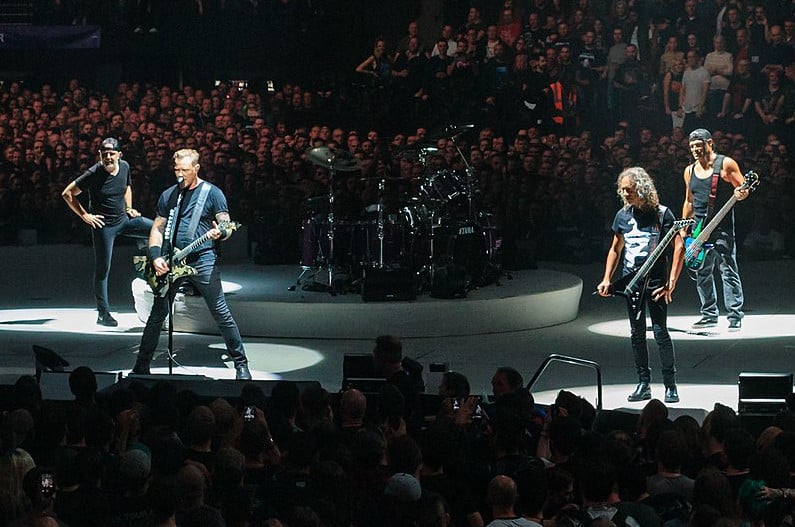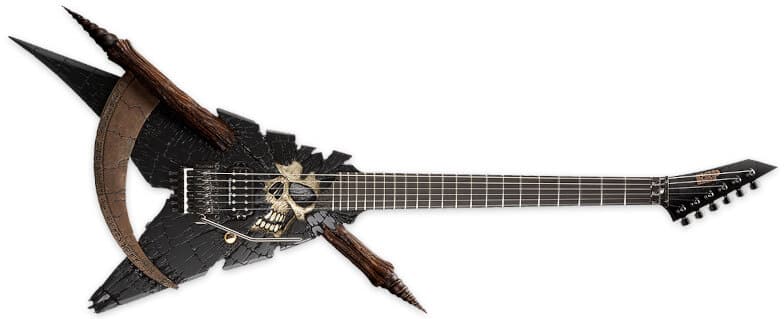Table of Contents
As we all know, Metallica is a legendary group. They play music that may be defined as a hybrid of heavy and thrash metal. Their music is highlighted by ferocious drumming, loud lyrics, and aggressive guitar riffs.
Metallica’s influence, however, goes beyond metal, as seen by their musical plurality which has allowed them to explore other genres and work with artists from a wide range of sounds.
This Killer Rig article seeks to explore and answer the question: what genre is Metallica? If you are ready, let’s check it out!
Key Takeaway
- The metal genre has been significantly influenced by Metallica. They gained popularity and had a significant impact on the development of the Bay Area metal scene in the 1980s.
- Metallica’s music encompasses multiple genres within the broader metal umbrella. Their “Master of Puppets” album is one of their hardest metal productions, and their heavy sound stands out by its aggressive and powerful nature.
- Additionally, Metallica was essential to the development and adoption of thrash metal. As one of the “Big Four” of thrash, they contribute to its definition and made the genre more popular by releasing albums like “Ride the Lightning.”
- In addition to heavy and thrash metal, Metallica drew influences from speed metal. The characteristics of speed metal, such as fast tempo and intense guitar riffs, can be heard in some of Metallica’s music, further diversifying their musical style.
Metallica’s Music Genres
I’ve always been fascinated by the various styles that inspire Metallica’s music, primarily because I’m a fan. So here, we’ll then look at every genre that Metallica experimented with over the course of their history.
We’ll start by exploring their roots in heavy metal, where their signature sound first began to take shape. Then, we’ll focus on the intense world of thrash and speed metal, two genres that Metallica helped define and popularize.

Heavy Metal
Heavy metal, with its roots deep in the aggressive guitar riffs, rapid drumming, and dark lyrical themes, is a genre that’s both powerful and intense. Metallica, with their iconic album “Master of Puppets,” epitomizes the depth and complexity of this genre.
This album, with its distorted guitars and thunderous drums, showcases Metallica’s ability to push the genre’s boundaries.
Heavy metal is more than just music; it’s an outlet for self-expression. Its cathartic energy resonates with many, transcending traditional musical boundaries.
This raw emotion is what draws listeners to the genre, and understanding its intricacies allows for a deeper appreciation of bands like Metallica and their significant contributions.
For those eager to go deeper into heavy metal, classic albums like “Kill ‘Em All” highlight Metallica’s innovative spirit. Engaging with live concerts or online heavy metal communities can also offer insights into this riveting music scene.
Characteristics of Heavy Metal
Heavy metal emerged in the late 1960s and early 1970s, popularized by bands like Black Sabbath and Led Zeppelin. Its defining features include:
- Aggressive Sound
- Distorted Guitars
- Complex Drum Patterns
- Intense Vocals
Metallica has significantly influenced this genre. Their songs, such as “Battery,” exemplify the aggressive sound, with fast-paced guitar riffs, heavy bass lines, and the commanding vocals of James Hetfield.
Thrash Metal
Thrash metal, marked by its aggressive guitar riffs, rapid tempo, and intense vocals, found a champion in Metallica. Their album “Ride the Lightning” stands as a testament to the genre’s raw power and Metallica’s pivotal role in its popularization.
Their innovative fusion of various sounds has significantly influenced other metal subgenres. Their groundbreaking approach has inspired bands to challenge traditional metal norms, leading to the birth of unique hybrid subgenres.
For artists aiming to harness the raw intensity of thrash metal, adopting its characteristic technical guitar riffs, swift instrumentation, and aggressive vocals is key. Drawing inspiration from influential albums like “Ride the Lightning” can further help in capturing the genre’s essence.
Metallica didn’t merely contribute to thrash metal; they revolutionized it.
Metallica’s Thrash Metal Revolution
Metallica’s influence in thrash metal’s emergence is undeniable. Their distinctive sound, characterized by aggressive tunes and intricate guitar riffs, helped shape the genre.
As part of the “Big Four” alongside Slayer, Megadeth, and Anthrax, Metallica played a foundational role in thrash metal’s 1980s evolution. Their albums “Kill ‘Em All” and “Ride the Lightning” introduced fans to thrash’s raw energy.
While Metallica remained rooted in thrash metal, they weren’t afraid to experiment, blending elements from punk, hardcore, and classical music. This genre-blending solidified their position in thrash, appealing to both mainstream and niche audiences.
The Big Four: Pillars of Thrash Metal
The “Big Four” – Metallica, Megadeth, Slayer, and Anthrax – are the cornerstone bands of thrash metal. Each has contributed uniquely:
- Metallica: Known for powerful compositions and a melodic thrash approach.
- Megadeth: Recognized for high-speed guitar riffs and profound lyrics.
- Slayer: Renowned for their dark, menacing energy.
- Anthrax: Merged thrash metal with hardcore punk influences.
These bands not only defined thrash’s sound but also popularized it. Metallica, in particular, achieved unparalleled commercial success, setting them apart in the quartet.
Speed Metal
Metallica, drawing from the high-energy subgenre of speed metal, carved a unique musical identity. Their signature rapid tempo, aggressive guitar riffs, and swift drumming encapsulate the essence of speed metal.
Metallica’s Speed Metal Roots: Influenced by bands like Motorhead and Judas Priest, Metallica adopted the frenzied nature of speed metal. Their penchant for intricate guitar solos and rapid drum patterns became defining elements of their sound.
Speed Metal Characteristics:
- Tempo & Technique: Speed metal is recognized for its high tempo, aggressive guitar riffs, and rapid double bass drumming.
- Technical Mastery: The genre emphasizes technical skill, featuring intricate guitar solos and complex song structures.
- Genre Fusion: Speed often blends elements of traditional heavy and thrash metal, resulting in a distinct sound.
Metallica’s foray into various genres allowed them to experiment with speed metal, adding a dynamic layer to their music that resonated globally.
Their speed metal influences not only inspired other bands, but also significantly impacted the broader heavy metal landscape.
Metallica’s Speed Metal Signature
- Dynamic Guitar Riffs: Metallica’s sound is enriched by the fiery guitar work typical of speed metal, characterized by intricate and lightning-fast riffs.
- Aggressive Drumming: Lars Ulrich’s drumming, marked by swift double bass pedals and rapid fills, embodies the power of speed metal.
- High-Energy Vocals: James Hetfield’s commanding vocals, inspired by the intense delivery of speed metal bands, complement the band’s energetic sound.
Metallica’s speed metal influences played a pivotal role in their musical evolution, contributing to their sound that defies genre norms.

Influence of Metallica on Other Metal Subgenres
Metallica’s profound impact on the metal music landscape is undeniable. Their pioneering role in shaping thrash, combined with their exploration of speed metal, has influenced countless bands and the evolution of various subgenres.
Their groundbreaking albums, such as “Ride the Lightning,” not only showcased their commanding sound but also laid the foundation for the rise of thrash metal globally. Drawing inspiration from bands like Motörhead, Metallica also played a pivotal role in defining the speed metal style.
Beyond specific subgenres, Metallica’s influence is felt in the broader metal community. They played a crucial role in bringing metal to mainstream audiences, breaking barriers that many thought insurmountable.
Their commercial success with albums like “The Black Album” demonstrated that heavy, aggressive music could achieve widespread appeal without compromising its core essence.
Metallica’s live performances, known for their raw energy and intricate stage setups, have set a standard for metal concerts.
Their elaborate stage designs, pyrotechnics, and fan engagement have influenced how bands approach live shows, emphasizing the importance of creating an immersive experience for fans.
Furthermore, their innovative approach to album production, often pushing the envelope in terms of sound engineering and mixing, has inspired a new generation of metal bands to prioritize production quality, ensuring that their music not only sounds good live but also on record.
Many prominent bands, including Megadeth, acknowledge Metallica’s significant influence on their musical direction, particularly in embracing thrash metal.
Conclusion
In the wide world of music, few bands have made a mark like Metallica. From their early days in thrash and speed metal to their role in bringing metal’s raw energy to bigger audiences, their legacy is clear and strong.
They’ve always been open to experimenting, mixing different types of music, urging other bands to do the same. Metallica’s influence can be seen all throughout metal music as it has evolved over time.
Whether you’ve been a fan for years or just know a few of their songs, it’s hard to deny: Metallica has shaped the industry in big ways, and they’ll keep making waves for a long time to come.

